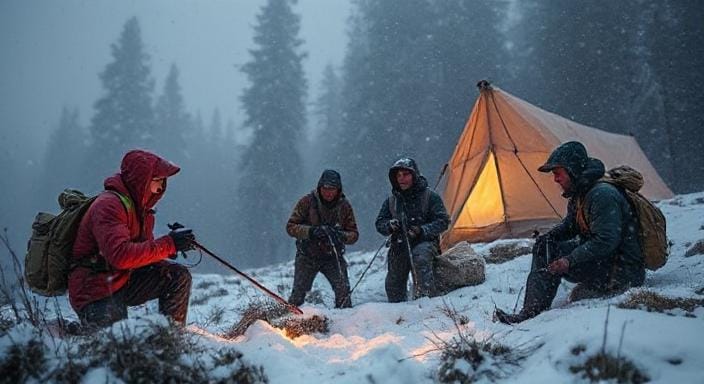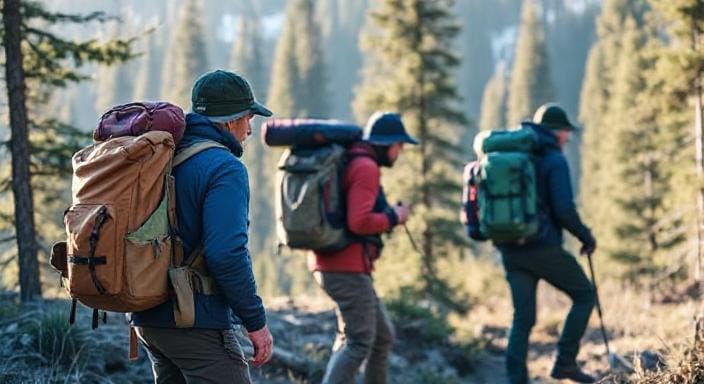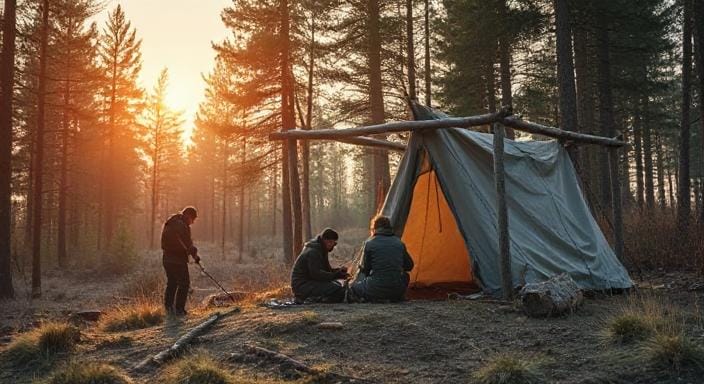Top Takeaways and Key Concepts
- Check weather patterns before any outdoor trip to avoid dangerous surprises.
- Wear layered, waterproof clothing to regulate temperature and stay dry.
- Build a sturdy, insulated shelter to protect from wind, rain, and cold.
- Master fire-starting skills to stay warm and cook in bad weather.
- Stay flexible and positive when plans change due to harsh conditions.
Summary of This Article
Please Note: This post may contain affiliate links. If you click one of them, we may receive a commission at no extra cost to you. As an Amazon Associate, I earn from qualifying purchases.
This article explains how to survive unpredictable outdoor weather by preparing smart and thinking ahead. It emphasizes checking weather conditions and understanding natural signs like wind direction and dark clouds. The article highlights the importance of proper gear, especially layered clothing, waterproof materials, and reliable hiking boots. Building a strong shelter using natural protection helps prevent exposure, while fire-starting skills are essential for warmth and cooking. Finally, it encourages staying calm, adapting plans during storms, and keeping a good sense of humor to handle any outdoor challenge successfully.
Short Video Version of this Article
So, you’ve made the choice to go outside. You might want to go on an amazing camping trip, or you might just want to get away from your in-laws for the weekend.

No matter what your motivation is, one thing is for sure: Mother Nature has her own ideas. And let’s be honest: she can be as unpredictable as a kitten on catnip! How can we get ready for anything she throws at us? Let’s get into the art of making our outdoor skills waterproof!
Learning About Weather Patterns

It’s important to know what the weather will be like before you go camping and dream of roasting marshmallows and singing campfire tunes.
When you go outdoors and think, “Hmm, this feels like a good day for a picnic,” you know what I mean. That may signal it’s going to rain a lot, or even worse, bears might decide they want your lunch right now.
Nature uses weather to keep us on our toes (and maybe even wet). It’s not just random events.
You can be better prepared by paying attention to the weather and studying how different circumstances affect your surroundings. For example, did you know that dark clouds aren’t just nature’s way of saying you have a poor hair day? They often mean that storms are coming!
And don’t forget about the direction of the wind! Have you ever tried to build a fire only to have it go out because of a sudden gust? Nature is saying, “Not today!” So pay attention to those breezes; they can help you decide where to camp or if you really need that huge umbrella.
Picking the Right Gear

After you know what Mother Nature might hurl at you, it’s time to pick out your clothing. I’m not saying you need as much gear as a small army, but having the correct tools may make all the difference between being toasty by the fire and shivering in your tent like an ice cube in Antarctica.
To start, get good clothes that can be worn in a range of weather. Think about layers—plenty and lots of them! This isn’t simply style advice; it’s also useful information for staying alive.
To prevent appearing like a drowned rat, start with moisture-wicking base layers (since no one likes soggy socks), then add insulating layers (to keep from being frostbite’s next victim), and then add waterproof outerwear.
And then there are boots—don’t cut corners here! You don’t want blisters that are so awful they could be in their own horror movie as you’re walking through muck. A good pair of hiking boots will support your ankles and keep your feet dry, unless you’re going through puddles that are deep enough for fish to swim in.
Putting Up Your Shelter

Now let’s speak about shelter because no one likes to be stuck under a flimsy sheet in the rain like a sad human origami project. When choosing a place to set up camp or build a shelter, seek for natural characteristics that will keep you safe from rain and wind, such as big trees or rock formations.
If you’re feeling brave (or foolish), you may attempt making a hut out of branches and leaves. It sounds fancy, but all you have to do is toss things together until they look like something that could hold you up without falling apart right away.
If your design seems like something from “Survivor,” you might want to think about it again!
Make sure your shelter is well-insulated on chilly nights or when it rains. Adding more leaves or even pine needles will help keep heat in and moisture out. This is a great combination unless you’d prefer cuddle with hypothermia.
Fire Skills: The Key to Staying Alive
Ah, yes—the beautiful flames! There is no better way to show that you are the master of your domain than to assemble around a fire that you started yourself. But before we get too enthusiastic about s’mores (which I fully support), let’s talk about how important fire is when the weather is bad.
Fire keeps you warm on cold evenings that seem a much like being inside an icebox, and trust me, no one wants frostbite as a camping gift! Also, cooking over flames gives us regular people who forgot to prepare food at home access to hot meals instead of cold granola bars…again.
To start a fire, you’ll need tinder (the stuff that catches fire fast), kindling (little sticks), and then bigger logs after the fire is going well.
If you can’t find matches because you didn’t plan ahead or because the wind took them away faster than squirrels can steal nuts, you can use flint and steel or even dryer lint (yes, really!) as backup choices.
Getting Through Hard Times: Rainy Days Ahead
Rain happens—it’s almost certain to happen when someone wants to get some fresh air outside their four walls! Don’t freak out if it rains while you’re camping; just change your plans!
First, make sure that all of your gear, from tents to down jackets, stays waterproof. This will keep you from being miserable and wet when you’re outside, where everything tends to turn into sponge-like messes overnight…yikes!
Second, think about changing your plans because sometimes reading in a tent is better than racing about outside in the rain trying to catch a picture of animals that would look great on Instagram.
Finally, always remember that humor may help you deal with stress, especially when things get harsh outside. So when storms hit out of the blue, tell jokes with your pals to remind them why they chose to live an adventurous life in the first place!
Embracing the Strange Things About Mother Nature
To sum up, people: to survive the elements, you need to understand how the weather works, get the right gear, build strong shelters, and learn basic skills—all while keeping a sense of humor amid all the craziness that Mother Nature sends our way. I all, who wouldn’t want to tell stories later about all the great fails they had along the way?
So get those bags ready. Grab your trusted friends and head toward the horizon, knowing that you can handle everything that comes your way, whether it’s sunlight or a heavy thunderstorm. Every encounter will shape the adventures that lie ahead!
Frequently Asked Questions
What is the most important step before heading outdoors?
The most important step is checking the weather forecast and understanding local weather patterns so you can plan and pack properly for changing conditions.
Why is layering clothing so important for outdoor survival?
Layering allows you to control your body temperature by adding or removing clothing as weather changes, while moisture-wicking and waterproof layers keep you dry and warm.
What should I look for when choosing a campsite for shelter?
Choose a spot protected from wind and rain, avoid low ground where water collects, and use natural features like trees or rocks for added protection.
How do I safely start a fire in bad weather?
Use dry tinder like bark, cotton, or dryer lint, shield your fire from wind, and rely on multiple ignition sources such as matches, lighters, or flint and steel.
What should I do if it starts raining during my trip?
Stay calm, keep gear waterproof, adjust plans as needed, and use your shelter and fire skills to stay warm and dry rather than risking exposure.
Why are waterproof boots necessary for survival trips?
Wet feet lead to blisters, cold, and even hypothermia; waterproof boots keep your feet dry and supported across rough terrain.
How can I stay positive during harsh weather conditions outdoors?
Use humor, flexibility, and a problem-solving mindset to adapt to changing situations and keep group morale high.
Suggested Resources:
Outdoor Survival Skills
https://www.outdoorsurvivalskills.com
Wilderness First Aid
https://www.wildernessfirstaid.com
The Ultimate Guide to Camping
https://www.campingguide.com

Kevin Collier is a seasoned outdoor enthusiast and writer for Trekbug.com, specializing in outdoor adventures, survival strategies, and prepping insights. With a deep love for nature and a commitment to self-sufficiency, Kevin empowers readers to embrace the wilderness confidently. He shares valuable tips, practical techniques, and inspiring stories, helping both novice and experienced adventurers develop essential skills for surviving and thriving in the great outdoors.





